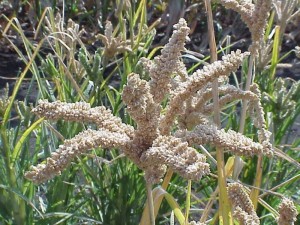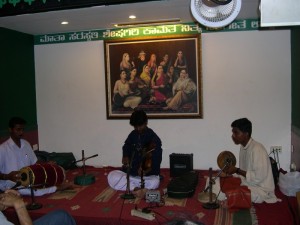A temporary Namaste!
Posted: May 23, 2011 Filed under: Uncategorized Leave a commentFolks, I have reached 10 blog entries, which was what was required for my university assessment. Therefore I’m taking a temporary break from the blog! If I suddenly find new health topics related to Indian food or new Karnataka recipes, I’ll definitely post them up! But for now, I bid you a temporary Namaste!
Hope you’ve enjoyed going on the Indian Food Safari with me!
Raagi Muddé- Recipe and health factors
Posted: May 23, 2011 Filed under: Health, Karnataka cuisine, Recipe | Tags: Dietician, Finger Millet, Glycemic Index, Khadai, Nutritionist, Raagi Mudde 2 CommentsI come to end of my blog post entries and I want to finish off with a recipe and its health factors/concerns. This dish is very popular in Karnataka, especially among the rural population and farmers. It is called Raagi Mudde. Raagi is Kannada for Finger Millet and this is what it is made from. Farmers, or labourers who have to put in long hours of physical work find that eating Raagi Mudde in the morning sustains them almost until dinner and keeps them energised throughout the day. However, contrary to the information presented in Wikipedia, and perceptions by the public, doctors like Dr. Rekha Rao dispute the health benefits of Raagi Mudde, saying it has a high glycemic index (GI). In a Times of India article, according to nutritionist and diabetes educator at Karnataka Institute of Diabetology, Vidya KP, several patients from rural areas eat Raagi Muddeand rice regularly everyday, both of which have high GI levels. Vidya says consuming the same type of nutrients during all meals everyday is dangerous.
Nuchinunde- Lentil Dumplings
Posted: May 22, 2011 Filed under: Uncategorized 4 CommentsI would now like to share with you, another Karnataka dish that is delicious and nutritious as a snack! It is called Nuchinundé. It is full of lentils. But best of all, it is steamed, not fried! So you can eat almost as much as you would like, guilt-free! Okay so here we go. Check out the recipe below!
Sige Kayi and Chigare Pudi- Ayurvedic Shampoo and Conditioner
Posted: May 22, 2011 Filed under: Ayurveda, Health | Tags: Acacia Concinna, Chigare Pudi, Conditioner, Ritha, Sapindus, Shampoo, Sige Kayi 6 Comments A slight deviation from food, this particular entry will delve into a shampoo substitute, known as Seege Kayi (Kannada) or Acacia Concinna. This is an Ayurvedic, medicinal plant, that is grown in central and South India. The fruit pods,leaves and bark are dried and ground into powder. It is available in powder form in India.
It was only a few years ago that I discovered this substitute while on a visit to Bangalore. My cousins use this concoction for their hair instead of shampoo. In fact, Sige Kayi is known as ‘fruit for hair’. People buy the powder, then make it into paste. To get some lather, people mix Albizia Amara powder (Kannada: Chigare Pudi) with Sige Kayi and apply this solution to their hair. Sige Kayi has low pH levels, making it mild. It also contains no chemicals, making it a safe option for hair.
According to Ayurvedic physician, Indu Narayan, Sige Kayi, or soap nut, belongs to the Sapindus family. She says it acts as an anti-bacterial, is also good for treating dandruff and also acts as mild detergents.
Soap nut powder can be combined with another powder commonly known as Ritha. These two in combination act as shampoo and conditioner for hair
I spoke to Aditi Sarovar, who lives in Bangalore, India. She said she uses Sige Kayi instead of shampoo because it gives her hair bounce and shine without injecting the chemicals present in shampoos.
For best results, I use Sige Kayi after applying castor oil to my hair beforehand. It makes my hair super soft and conditioned. I also noticed that Sige Kayi has gone commercial so I bought a body soap bar that contains it. I tried the soap and it made my skin super soft.
I think this has inspired me to try this chemical-free alternative to shampoo and conditioner. I’ll try it and see what happens!
Jolada Rotti- Cuisine of North Karnataka
Posted: May 11, 2011 Filed under: Karnataka cuisine | Tags: Areca Nut, Bakri Oota, Banana Leaf, Bangalore, Betal Leaf, Chutney Pudi, Cinemon Banana, Enne Gai, Huli, Jolada Rotti, Lassi, North Karnataka, Pickle, Raita, Saaru 5 CommentsWhile we enjoy most of the dishes in Australia that are special to Karnataka, there is one cuisine that is unavailable here. That is why we make it a point to eat this cuisine every time we go to Bangalore. It is Jolada Rotti Oota (meal), a cuisine that is native to North Karnataka. I haven’t actually had this meal in North Karnataka, but we go to a restaurant in Bangalore, which specifically serves a whole meal from this cuisine.
Recipe- Saagu
Posted: May 5, 2011 Filed under: Health, Karnataka cuisine, Recipe, Spices | Tags: Chapati, Curry Leaves, Grinder, Karnataka Food, Peeled almonds, Poori, Poppy Seeds, Saagu, Tadka, Vegetables Leave a commentIt’s time for another recipe. This time, I’d like to share with you, a recipe that is specifically from Karnataka. The dish is called Saagu. This dish is a personal favourite, mainly because it is filled with fresh vegetables and flavoursome spices. I learned this one from my grandmother, although my mother makes it as well.



